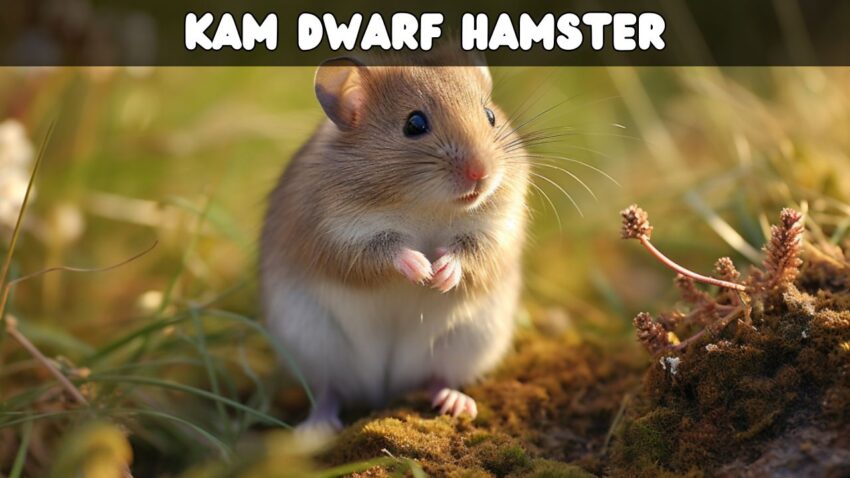In the vast universe of small pets, few creatures capture the imagination as vividly as the Kam Dwarf Hamster. With its diminutive stature, charismatic behaviors, and distinctive appearance, this particular hamster species has garnered much adoration from enthusiasts worldwide. As we venture into this comprehensive guide, readers will be taken on a journey that unravels the mystique surrounding the Kam Dwarf Hamster, offering valuable insights into its life and unique traits.
The Intriguing Journey of the Kam Dwarf Hamster
Beyond their cute demeanor, Kam Dwarf Hamsters possess a rich history and an evolutionary journey that distinguishes them from their furry counterparts. These creatures have traversed various terrains, adapting and evolving, making their tale from the wild terrains to the cozy corners of our homes a narrative filled with wonder and discovery.
The Kam Dwarf Hamster: A Species Worth Exploring
Among the myriad of hamster species populating our world, the Kam Dwarf Hamster stands out, not just because of its physical allure but also due to its intriguing behaviors and habits. This article delves deep into the life of the Kam Dwarf Hamster, shedding light on every aspect of its existence. Our emphasis on the term “Kam Dwarf Hamster” not only aids in SEO optimization but also serves as a testament to the importance and distinctiveness of this species within the broader hamster community.
What Sets the Kam Dwarf Hamster Apart?
From its diet to its nocturnal rhythms, every detail about the Kam Dwarf Hamster warrants exploration. By immersing ourselves in the world of this hamster species, we hope to foster a deeper understanding and appreciation among current and future pet owners. This guide aims to be a cornerstone resource for anyone intrigued by the Kam Dwarf Hamster, offering answers, insights, and guidance on ensuring the well-being of these delightful creatures.
Overview

The world of hamsters is a tapestry of diverse species, each with its own unique story, and at the heart of this rich tapestry is the Kam Dwarf Hamster. This section serves as a primer, setting the stage for a deeper exploration of this delightful creature, its roots, and its role in our lives.
Tracing the Roots: Kam Dwarf Hamster’s Origins
Originating from specific regions that have shaped its characteristics over millennia, the Kam Dwarf Hamster has a storied past. Its evolutionary journey has seen it adapt to various habitats and challenges, which have, in turn, endowed it with its distinctive traits and behaviors. The narrative of the Kam Dwarf Hamster is a blend of survival, adaptability, and evolution, making it an embodiment of nature’s wondrous ways.
From Wild Terrains to Domestic Bliss: The Kam Dwarf Hamster’s Dual Life
While many might recognize the Kam Dwarf Hamster from pet stores or a friend’s home, its existence in the wild is a tale less told. In its natural habitat, the Kam Dwarf Hamster showcases behaviors and survival tactics that are both fascinating and instructive. Contrasting this with its domesticated life, we see a creature that, despite its wild instincts, has seamlessly integrated into human households, winning hearts with its antics and charm. This dual existence, being a creature of the wild and a beloved pet, positions the Kam Dwarf Hamster as a unique species, offering insights into the broader dialogue about nature, domestication, and coexistence.
Natural Habitat

The Kam Dwarf Hamster’s habitat is a testament to nature’s ingenuity and adaptability. While these creatures are now widely recognized as household pets, their origins trace back to distinct environments that have influenced their biology, behavior, and overall disposition. In this section, we embark on a journey to understand the natural habitats of the Kam Dwarf Hamster and the elements that have molded this captivating species over time.
Geographic Footprints: Where the Kam Dwarf Hamster Calls Home
Deep into specific regions, one would find the habitats where the Kam Dwarf Hamster has etched its presence. These locales, often characterized by their unique terrains and flora, provide the hamster with both shelter and sustenance. The biodiversity of these areas, combined with the hamster’s resourceful nature, has led to a symbiotic relationship between the creature and its environment. Here, the Kam Dwarf Hamster, though small in stature, plays a significant role in the ecological balance, participating in various food chains and contributing to the overall health of its ecosystem.
Climate and Terrain: Nature’s Canvas for the Kam Dwarf Hamster
The climates of these regions are as varied as the landscapes themselves. From temperature variations to seasonal shifts, the Kam Dwarf Hamster has evolved to endure and thrive amidst these changes. Its fur, behavior, and even dietary habits are reflections of the climatic conditions it has been exposed to. The terrains, which might range from rocky outcrops to lush vegetation, also play a pivotal role in shaping the hamster’s daily routines and survival strategies. Understanding these ecological factors provides a lens into the resilience and adaptability of the Kam Dwarf Hamster, painting a picture of a creature perfectly attuned to its surroundings.
Physical Characteristics

The Kam Dwarf Hamster, with its distinctive features, holds a unique place in the rodent family. Its physical attributes not only contribute to its adorable appearance but also equip it with the necessary tools to navigate its environment efficiently. In this section, we delve deep into understanding the nuanced details of its anatomy, from the intricacies of its fur patterns to its dynamic stature.
Size and Stature: The Petite Marvel of the Rodent World
Compact yet agile, the Kam Dwarf Hamster’s size is one of its defining features. Typically measuring in at a range of specific centimeters, it’s among the smaller hamster breeds. But don’t let its diminutive size fool you; this hamster possesses a vitality and energy that’s truly remarkable. The proportion of its body, combined with its nimble feet and dexterous paws, allows it to maneuver through tight spaces and swiftly dart from one place to another, be it in the wild or within the confines of a well-crafted habitat in a domestic setting.
Fur Coloration and Distinctive Marks: Nature’s Artistry at Play
The fur of the Kam Dwarf Hamster is a masterpiece of nature, reflecting both its genetic lineage and environmental adaptability. Its color palette may vary, but common hues paint a tapestry of browns, whites, and perhaps even grays, often interspersed with unique patterns or patches. These color variations not only lend the hamster its striking appearance but also play a pivotal role in camouflaging it from potential predators in the wild. Additionally, the texture and density of its fur provide insulation against the varying temperatures of its natural habitat, acting as a protective shield against the elements.
Through these physical characteristics, the Kam Dwarf Hamster stands as a testament to nature’s attention to detail and the wonders of evolution.
Behavior and Temperament

The Kam Dwarf Hamster is a creature of habits, nuances, and delightful surprises. It’s not merely its physical attributes that make it a favorite among enthusiasts but also its behavior, which presents a dynamic interplay of instincts, adaptations, and personality. This section will provide readers with an enlightening exploration into the day-to-day activities, temperament, and unique behavioral traits of this captivating rodent.
Daily Rhythms: A Life Led on Fast Forward
Kam Dwarf Hamsters are bustling beings. Their day often begins with a stretch and a swift grooming session, using their tiny paws to comb through their fur and keep themselves tidy. As crepuscular animals, they are most active during dawn and dusk, utilizing these times to explore, forage, and play. Their innate curiosity drives them to investigate every nook and cranny, be it in the wild or within their cage. The incessant gnawing, a common trait among hamsters, keeps their ever-growing teeth in check. One may also observe them indulging in bouts of spontaneous sprints on their exercise wheel, a testament to their boundless energy.
Social Interactions and Disposition: The Dual Sides of a Coin
In terms of social interactions, Kam Dwarf Hamsters display a fascinating range of behaviors. While they can be affectionate and form strong bonds with their human caregivers, they have a tendency to be territorial. This territorial nature means that, unlike some other hamster species, they might prefer solitude or the company of familiar cage mates. When introduced to new companions, a careful and gradual introduction process is crucial to avoid conflicts. Their vocalizations, ranging from gentle squeaks to more assertive chatters, provide insights into their moods and feelings.
Signature Moves: The Unique Dance of the Kam Dwarf
Every species has its quirks, and the Kam Dwarf Hamster is no exception. One of its signature behaviors includes ‘hoarding.’ With cheek pouches that can stretch back to their shoulders, they store food and transport it to their nests. This behavior, reminiscent of their wild ancestors who had to save up for times of scarcity, is both amusing and endearing to watch. Another notable trait is their meticulous nest-building skill. Using available materials, they create cozy and intricate burrows, ensuring they have a safe and warm place to rest and hide.
Through a comprehensive understanding of their behavior and temperament, one gains not just knowledge but a profound appreciation for the Kam Dwarf Hamster, a creature of immense charm and complex instincts.
Diet and Nutrition

The diet of the Kam Dwarf Hamster isn’t merely a facet of its daily routine but a critical aspect of its overall well-being. Like any species, these hamsters have evolved to thrive on a particular range of nutrients, which, when met, ensures their health, vitality, and longevity. In this section, we’ll explore the dietary preferences of the Kam Dwarf Hamster, delve into its specific nutritional requirements, and shed light on certain foods that should be approached with caution or avoided altogether.
A Gourmet in the Rodent World: The Kam Dwarf’s Dietary Staples
Kam Dwarf Hamsters, in their natural habitat, primarily subsist on a varied diet of seeds, grains, and insects. Seeds, such as sunflower and sesame, provide them with the essential fats and proteins, while grains like millet and barley offer carbohydrates for energy. They also have an inherent penchant for fresh greens and vegetables like kale, spinach, and broccoli, which supply them with essential vitamins and minerals. On occasions, they’d hunt for insects, a rich protein source that mimics their predatory side in the wild. In captivity, a balanced hamster mix, available in pet stores, can replicate this diet, providing them with a diverse range of nutrients.
Tailored Nutritional Needs: Beyond Just Food
Water, undoubtedly, forms an indispensable part of the Kam Dwarf Hamster’s diet. Fresh and clean water should be accessible to them at all times. Additionally, while they have a fondness for fruits, due to their natural sugars, these should be given sparingly and considered more as treats rather than regular diet components. Calcium is another vital mineral for them, essential for bone health. Cuttlefish bones or mineral blocks, often used for birds, can be a good source and also assist in wearing down their continuously growing teeth.
Red Flags in the Feast: Foods to Be Wary Of
Despite their omnivorous nature, not all foods are safe for Kam Dwarf Hamsters. Certain foods can be harmful or even toxic. Citrus fruits, for instance, are too acidic and can upset their stomach. Almonds contain cyanic acid and should be avoided. Likewise, onions, garlic, and chocolate are toxic and can lead to severe health issues. It’s also essential to ensure any fresh produce given is free from pesticides. As a rule of thumb, when in doubt about a particular food’s safety, it’s best to consult with a veterinarian or expert before introducing it to the hamster’s diet.
To sum it up, the dietary regimen of the Kam Dwarf Hamster is a blend of nature’s offerings and a touch of human intervention to ensure they get the best of both worlds. Being informed about their needs and potential diet dangers can significantly contribute to their happiness and longevity in captivity.
Housing and Environment

The Kam Dwarf Hamster, like all living beings, requires a habitat that mimics its natural environment as closely as possible. This not only ensures its comfort but also its overall health and well-being. Creating the right environment is crucial, as it directly influences the hamster’s quality of life. In this section, we will guide you through the intricacies of setting up a haven for your Kam Dwarf Hamster, addressing essential aspects like cage size, bedding choice, and other pivotal environmental components.
The Ideal Abode: Cage Specifications
Choosing the right cage for a Kam Dwarf Hamster is the first and perhaps most significant step. A spacious cage, preferably one that is at least 24 inches in length, 12 inches in width, and 12 inches in height, provides ample room for the hamster to roam, exercise, and engage in natural behaviors. A cage with horizontal bars can offer them the chance to climb, a fun activity they often indulge in. While wire cages are popular, it’s essential to ensure the gaps between bars are narrow enough to prevent escapes. If opting for a tank or bin cage, proper ventilation is a must to ensure fresh air circulation.
Comfort Underfoot: Bedding Choices
Bedding material plays a dual role: it offers comfort and aids in maintaining hygiene. Aspen or paper-based beddings are both excellent choices for Kam Dwarf Hamsters. They’re absorbent, free from harmful chemicals, and provide a soft underfoot for the hamster. A depth of at least 2 inches allows them to burrow, a natural behavior they immensely enjoy. Cedar or pine wood shavings, though commonly available, should be avoided due to the presence of aromatic oils which can be harmful to hamsters.
The Perfect Ambiance: Essential Environmental Touches
Beyond the cage and bedding, a few additional touches can make the Kam Dwarf Hamster’s home complete:
- Hiding Spots: Hamsters, by nature, are prey animals and appreciate having places to hide and feel safe. Providing multiple hiding spots or shelters, like small wooden huts or ceramic hides, can offer them this sense of security.
- Exercise Essentials: A well-sized exercise wheel is vital. Ensure it’s solid (not wire) to prevent foot injuries and is wide enough to avoid back arching when they run.
- Toys and Chews: Wooden toys, bridges, tunnels, and chew toys can keep the Kam Dwarf Hamster entertained and also help in naturally trimming their ever-growing teeth.
- Temperature and Lighting: Maintaining a consistent temperature, ideally between 65°F to 75°F, and mimicking a natural day-night light cycle is vital for their circadian rhythm.
In wrapping up this section, the essence lies in understanding and replicating the Kam Dwarf Hamster’s natural habitat. An environment that caters to their physical needs, while also offering mental stimulation, ensures a happy, active, and long-lived hamster companion.
Health and Wellness

Every pet owner’s primary concern is the health and well-being of their animal companion. The Kam Dwarf Hamster, with its compact size and delicate nature, warrants specific attention in this regard. Although generally robust when provided with the right care, these hamsters, like all pets, can face health challenges. Equipped with the right knowledge and a proactive approach, you can ensure that your Kam Dwarf Hamster remains in optimal health. In this section, we’ll delve into the common health issues that might affect these adorable creatures and provide guidance on both prevention and early detection.
Common Health Concerns and Prevention
Kam Dwarf Hamsters, due to their genetic makeup and environmental factors, can be susceptible to certain health conditions:
- Respiratory Issues: Symptoms might include labored breathing, nasal discharge, or frequent sneezing. Ensure their environment is clean, well-ventilated, and free from drafts to prevent these ailments.
- Wet Tail: A severe diarrheal disease often caused by stress or bacterial infections. Keeping their cage clean and avoiding sudden dietary changes can reduce the risk.
- Dental Problems: Overgrown or misaligned teeth can lead to difficulty eating. Provide chew toys and hard vegetables to help naturally wear down their teeth.
- Tumors: Lumps or bumps could be benign or malignant growths. Early detection is key, so regular gentle handling and inspections can help spot abnormalities.
Recognizing the Signs and Seeking Veterinary Care
An essential aspect of pet care is early detection. Often, small animals like the Kam Dwarf Hamster can mask their symptoms, making early intervention crucial. Here are some general signs that your hamster might be under the weather:
- Behavioral Changes: A usually active hamster becoming lethargic, or a change in eating and drinking habits.
- Physical Symptoms: Unexplained weight loss, bald patches, swelling, or wounds.
- Changes in Droppings: Diarrhea or overly dry feces can indicate digestive issues.
- Coordination Issues: Stumbling, tilting heads, or circling can be signs of neurological problems or inner ear issues.
While periodic health checks at home are beneficial, the importance of professional veterinary care cannot be stressed enough. If you spot any of the symptoms mentioned above or have concerns about your Kam Dwarf Hamster’s health, it’s always a wise decision to consult with a veterinarian, preferably one specializing in small mammals.
To conclude this section, ensuring the health and wellness of your Kam Dwarf Hamster revolves around three core principles: proactive care, early detection, and timely intervention. Armed with this knowledge, you’re better equipped to provide a safe, happy, and healthy life for your petite companion.
Breeding

Breeding any pet, including the Kam Dwarf Hamster, is a significant responsibility that should never be undertaken lightly. Breeding requires extensive knowledge about the species, a deep commitment to the well-being of both the parents and the offspring, and the resources to provide appropriate care. If you’re considering breeding your Kam Dwarf Hamsters or simply curious about the process, this section aims to provide a comprehensive overview.
Understanding the Breeding Process
The Kam Dwarf Hamster, like other hamsters, has specific mating behaviors and processes. The females come into estrus (a period of fertility) approximately every 4 days and are receptive to mating. During this period, females may emit a mild scent, and their behavior might become more active. Males, recognizing these cues, will show increased interest.
- Preparation: Prior to introducing a pair for mating, it’s vital to ensure both hamsters are healthy. This includes a check-up for any underlying health issues and ensuring they’re of optimal breeding age.
- Introduction: A neutral space, devoid of territorial markers, is ideal for introducing the pair. Initial meetings should be supervised to prevent aggressive confrontations.
- Post-Mating Care: Once mating has occurred, the male should be separated to provide the female with a calm environment to nurture her impending litter. This also prevents overbreeding.
Creating Conducive Conditions
Breeding success often depends on mimicking, as closely as possible, the natural conditions under which these animals breed in the wild.
- Habitat: Ensure the female’s cage is warm, quiet, and away from frequent disturbances. Nesting materials, such as soft hay or shredded paper, should be provided.
- Nutrition: Pregnant and nursing females require a diet rich in protein. Offering high-quality hamster food, supplemented with boiled eggs, lean chicken, or tofu, can be beneficial.
- Safety: As the delivery date approaches, minimize handling the female to reduce stress. After birth, avoid touching the pups for at least two weeks, unless absolutely necessary, to prevent the mother from rejecting or harming them.
Ethical Breeding Considerations
Breeding should always prioritize the health and welfare of the animals over any other considerations, such as potential profit or mere curiosity.
- Purpose: Before breeding, ask yourself why you’re choosing to do so. Are homes already lined up for the potential offspring? Are you prepared for the possibility of a large litter?
- Overpopulation: With many hamsters already in need of homes, it’s crucial to consider whether breeding is exacerbating the problem of pet overpopulation.
- Genetics: Responsible breeders are well-versed in the genetic backgrounds of their hamsters to prevent inbreeding and the transmission of undesirable or harmful traits.
- Lifespan: Remember, baby hamsters grow quickly and will soon require the same amount of care, attention, and resources as adults.
Breeding the Kam Dwarf Hamster, or any pet, is a commitment that extends well beyond the birth of the babies. It’s about being responsible for multiple lives, ensuring their well-being, and making informed, ethical choices throughout the process. If you’re ever in doubt, seeking advice from seasoned breeders or veterinarians can be an invaluable step in the right direction.
FAQs

The Kam Dwarf Hamster, with its unique characteristics and care requirements, often piques the curiosity of pet enthusiasts. Whether you’re considering adding one of these tiny wonders to your family or you’re a seasoned owner looking for some clarifications, this FAQ section addresses some of the most commonly asked questions about the Kam Dwarf Hamster.
What is the average lifespan of a Kam Dwarf Hamster?
The Kam Dwarf Hamster typically lives between 1.5 to 2.5 years, although with optimal care, some individuals might reach 3 years. Their lifespan is influenced by factors like genetics, diet, general care, and living conditions.
How often should I clean my Kam Dwarf Hamster’s cage?
A general recommendation is to spot clean the cage daily, removing soiled bedding and uneaten fresh foods. A thorough cleaning, which involves changing all the bedding and disinfecting the cage, should be done at least once a week.
Are Kam Dwarf Hamsters nocturnal?
Yes, like most hamster species, the Kam Dwarf Hamster is primarily nocturnal, which means they are most active during the night. However, some might occasionally be active during the late afternoon or early morning.
Can I house multiple Kam Dwarf Hamsters together?
Kam Dwarf Hamsters can be social and might cohabit peacefully, especially if introduced at a young age. However, close monitoring is essential, as disputes can arise. Ensure the cage is spacious with multiple hideouts to minimize territorial conflicts.
What should I feed my Kam Dwarf Hamster?
A well-balanced hamster pellet should form the basis of their diet, supplemented with small amounts of fresh fruits, vegetables, and occasional protein sources like boiled eggs or lean chicken. Always introduce new foods gradually and in moderation.
Do Kam Dwarf Hamsters bite?
While they’re generally gentle creatures, Kam Dwarf Hamsters might bite if they feel threatened or are not accustomed to handling. It’s essential to handle them gently and regularly to build trust and minimize biting incidents.
Is a wheel necessary for my Kam Dwarf Hamster’s cage?
Yes, a wheel provides an excellent opportunity for the Kam Dwarf Hamster to exercise, which is crucial for its physical health and mental well-being. Ensure the wheel is solid-surfaced to prevent any injuries.
How can I tell if my Kam Dwarf Hamster is stressed or unwell?
Signs of stress or illness include reduced activity, changes in eating or drinking habits, hair loss, hunched posture, or abnormal discharges. If any of these symptoms are observed, it’s recommended to consult a veterinarian experienced with small pets.
Understanding the intricacies of the Kam Dwarf Hamster’s needs and behaviors ensures a more enriching experience for both the owner and the pet. Always prioritize their well-being and don’t hesitate to seek expert advice when in doubt.
Summing Up

The enchanting world of the Kam Dwarf Hamster, with its unique quirks and characteristics, offers both challenges and joys to its caregivers. We have journeyed through a multitude of facets associated with this intriguing species, from its natural habitats and dietary preferences to the specifics of health, breeding, and common queries.
Key Takeaways
- The Kam Dwarf Hamster stands out not only in its physical attributes but also in its behavior and temperament.
- An understanding of its natural environment and habitat is essential to replicate those conditions in captivity, ensuring the hamster’s health and happiness.
- Proper diet, timely healthcare, and a conducive living environment are pivotal to the well-being of these petite pets.
- Ethical breeding practices should always be emphasized, ensuring the continued health and vitality of future generations.
- The myriad of questions that arise when considering or caring for a Kam Dwarf Hamster underscores the importance of continuous learning and sharing of knowledge.
A Call to Act
To all the readers who have embarked on this enlightening exploration with us, we encourage you to disseminate this reservoir of information far and wide. The more informed potential and current pet owners are, the better the quality of life for our tiny furry friends. Remember, adopting any pet, including the Kam Dwarf Hamster, is a significant commitment. Always approach it with thorough research, understanding, and a heart full of compassion. Let’s all be ambassadors of responsible pet ownership and the love and care these delightful creatures so rightly deserve.

